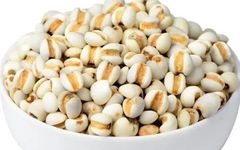————————————————————————————————————————————————————————————————–
Coix seed, known as Yi Yi Ren (薏苡仁, Coix lacryma-jobi), is the mature seed of the plant belonging to the Poaceae family, which is an annual or perennial herb. The plants are harvested in autumn when the fruits are ripe, dried, and the seeds are separated from the husk, yellowish seed coat, and impurities. Coix seed is characterized by its easy digestibility and absorption, making it a gentle remedy whether used for nourishment or medicinal purposes.
Coix seed has a long history of cultivation in China and is one of the ancient grains that serve both as food and medicine. It is produced in most regions of the country, primarily in provinces such as Fujian and Hebei. Due to its high nutritional value, it is hailed as the “King of Grasses” and the “Grain of Life and Health”. Recently, it has been classified as an anti-cancer food in Japan, significantly increasing its value.
1. Coix seed contains various vitamins and minerals that promote metabolism and reduce gastrointestinal burden, making it a beneficial food for patients who are weak during or after illness;
2. Regular consumption of coix seed products is effective for chronic enteritis, indigestion, and other conditions. Coix seed can enhance kidney function and has a heat-clearing and diuretic effect, thus benefiting patients with edema;
3. Modern pharmacological studies have proven that coix seed has anti-cancer properties, with effective components including selenium, which can effectively inhibit the proliferation of cancer cells and can be used as an adjunct treatment for gastric cancer and cervical cancer;
4. Healthy individuals who frequently consume coix seed can maintain agility and reduce the incidence of tumors;
5. Coix seed contains a certain amount of vitamin E, making it a beauty food that can maintain skin luster and delicacy, eliminate acne and pigmentation, improve complexion, and has certain therapeutic effects on warts caused by viral infections;
6. Coix seed is rich in vitamin B, which is very beneficial for the prevention and treatment of beriberi.
Suitable groups for sweet coix seed porridge:
1. Suitable for patients with various cancers, arthritis, acute and chronic nephritis with edema, cancerous ascites, facial swelling, beriberi, warts, beauty seekers, young flat warts, common warts, molluscum contagiosum, young acne, and other skin nutritional deficiencies and roughness, as well as those with lung atrophy and lung abscess;
2. According to previous experiences, women in early pregnancy should avoid it; additionally, those with low sweat and constipation should not consume it.
1. Fresh coix seed can be boiled into soup to help eliminate dampness and wind; for strengthening the spleen and benefiting the stomach, it should be cooked and eaten.
2. Coix seed can be consumed as food, cooked into porridge or soup. In summer and autumn, it can be boiled with winter melon, serving both as a meal and to clear heat and eliminate dampness.
3. Boil fresh milk, add an appropriate amount of coix seed powder, stir well, and consume. Regular consumption can maintain skin luster and delicacy, eliminate acne, freckles, age spots, pregnancy spots, and butterfly spots.
Coix seed has a sweet taste and is specifically used to eliminate dampness and alleviate joint stiffness, lung abscess, and lung atrophy.
It is the mature seed of the perennial herb Yi Yi (薏苡, Coix lacryma-jobi) from the Poaceae family. It is produced in most regions of the country, primarily in Fujian and Hebei provinces. The fruits are harvested in autumn, dried, and the husk and seed coat are removed to collect the seeds, which can be used raw or cooked.
Taste and properties: Sweet, bland, slightly cold. It enters the spleen, stomach, and lung meridians.
Functions and indications: Promotes urination and drains dampness, strengthens the spleen and stops diarrhea, clears heat and expels pus. It is used for spleen deficiency with dampness, diarrhea, edema, beriberi, lung abscess, intestinal abscess, and urinary difficulty.
Dosage and administration: 19-30g.
Clinical application: This product is mildly damp-draining and slightly cold, primarily clearing damp-heat while also strengthening the spleen, suitable for conditions of spleen deficiency with excess dampness, dampness descending, and lung abscess.
Folk Prescription 1: Ischial Bursitis
Daily, boil 60g of fresh coix seed in water and take in two doses. (Journal of Traditional Chinese Medicine)
Folk Prescription 2: Women’s Yellow Discharge
Roasted coix seed, Huang Bai (黄柏, Phellodendron amurense), and lotus seeds (without core and skin), each 60g. Grind into a fine powder, mix with honey to form pills the size of a walnut. Take 10g with warm water on an empty stomach twice daily.
Folk Prescription 3: Flat Warts
Grind fresh coix seed into powder, mix with an equal amount of white sugar, and take one spoon with warm water 2-3 times daily for 7-10 days. (Journal of Traditional Chinese Medicine)
Folk Prescription 4: Molluscum Contagiosum
50g of coix seed, 30g of Da Qing Ye (大青叶, Isatis tinctoria), 30g of Ban Lan Gen (板蓝根, Isatis indigotica), and 7.5g of Sheng Ma (升麻, Cimicifuga foetida). One dose daily, boiled in water. (Clinical Dermatology Journal)
Folk Prescription 5: Condyloma Acuminatum
500g of fresh coix seed ground into powder, mixed with 500g of white sugar, taken orally three times daily, one tablespoon each time. (Liaoning Journal of Traditional Chinese Medicine)
↓↓↓↓↓
.
Recommended: For more folk medicine and health information, scan the QR code below to learn more↓↓↓↓↓


The knowledge left by our ancestors is often simple yet practical!
If you find it useful, save it and share it with your friends; it can truly help everyone!
Disclaimer: This article is reproduced from the internet and published materials. If there is any infringement, please contact us for removal. The various prescriptions and folk remedies mentioned are for informational sharing only and do not constitute medical advice, recommendations, or guidance. Please use them under the guidance of a physician.

